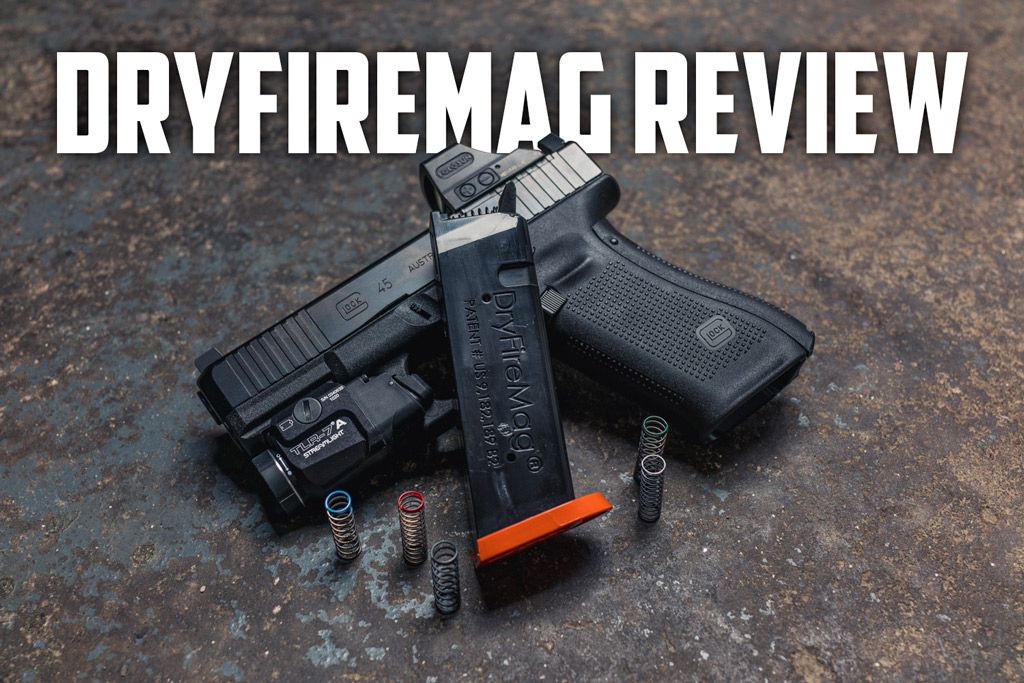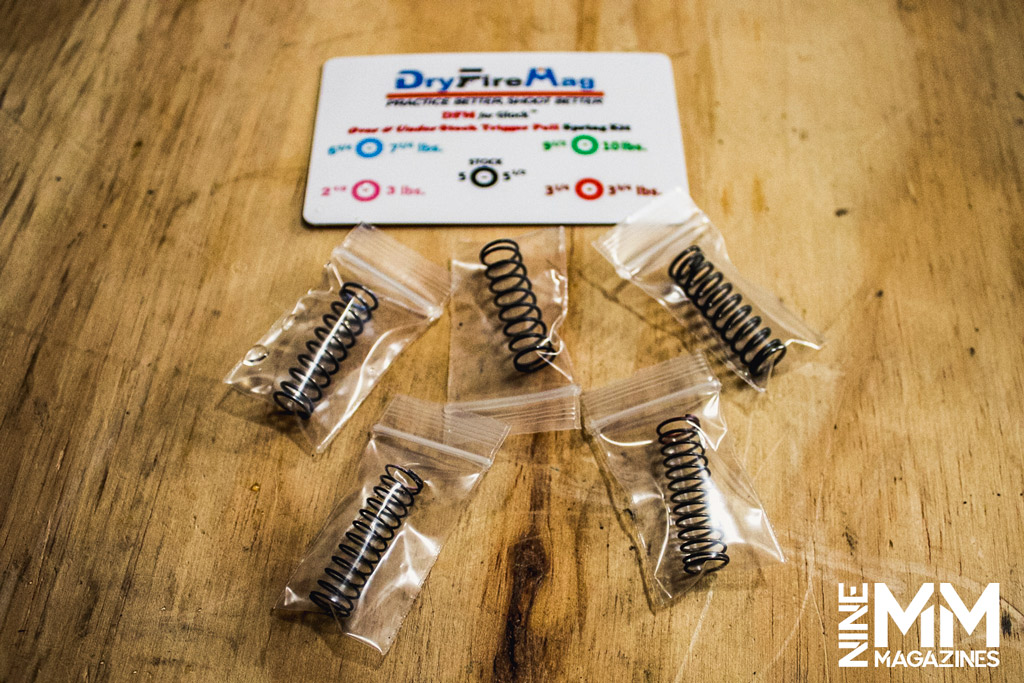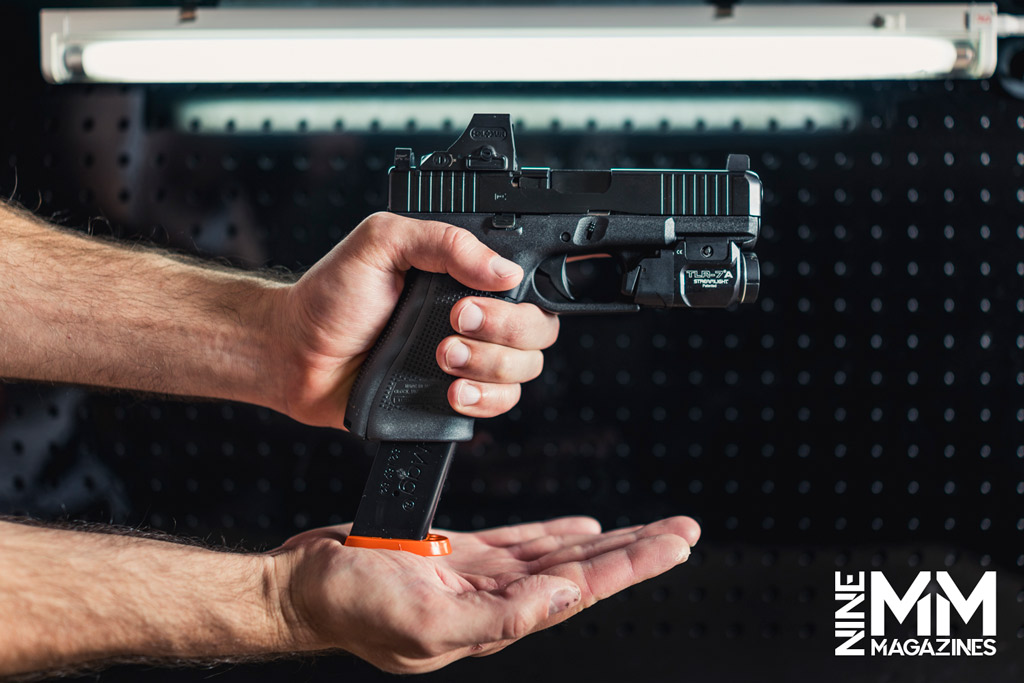
Dryfiremag Review
Disclaimer: This page contains affiliate links, meaning we receive commissions for any purchases made through the links on this page.
A dry fire training magazine is the perfect tool to improve accuracy, correct recoil flinching, and work on perfecting trigger pull. The DryFireMag training magazine for Glock replicates the weight and feel of a fully-loaded magazine without any ammunition in it. Dry firing at home may not be as exciting as live fire on the range, but when done right, it can improve your shooting dramatically.
The DryFireMag is designed to fit all generations of 9mm, .40 caliber, .357 caliber, 10mm, .45 ACP, and .45 G.A.P. Glock pistols that use a double-stack magazine, making it a very versatile product to use with different pistols. One of the important things to note is that you should never rack the slide of your Glock pistol with the dry fire magazine inserted. This warning is clearly labeled and it can damage your gun.
Can A Dry Fire Training Magazine Improve Your Shooting?

If you’ve ever dry-fired at home or on the range before a practice session, you are probably familiar with having to rack the slide to reset the trigger after each trigger pull. With this dry fire training magazine, that is a thing of the past. This magazine provides a simulation of the firing pin release and trigger reset. Your support hand never has to rack the slide between trigger pulls.
What does this mean? Practicing your doubles just got even easier. It does the work for you just like how a real semi-automatic would function in live-fire. Giving you the ultimate advantage in practice sessions to train how you shoot. How does it feel? It’s well made. However, the quality of the plastic feels more like a third-party magazine than a real Glock brand one.
When you first put the magazine into the gun, it is very hard to insert. At first, I thought the magazine was out of spec, but after confirming with the directions provided, I found that this is completely normal. Give the bottom of the magazine a hard tap with your palm to ensure it is seated in the gun. The first trigger pull will feel like a 20-pound trigger pull, but then the gun is ready to go!
Dryfiremag For Competition Shooting
Most people who dry fire are competitive shooters working on improving their shooting game. This also means that their gun is probably modified in some way or another. While the stock Glock triggers are easy to use right out of the box, a competition trigger can make all the difference. Especially when it comes to splits and recoil management.
The Dryfiremag comes with five springs that increase or decrease the weight of the stock trigger pull. If you’re used to a lighter pound trigger pull and want to practice what you shoot with, use the red or pink spring. If you’re really trying to work on a proper trigger press without moving the gun, try using the heavier green or blue spring.
One of the really neat features of the dry fire training magazine is the audible sounds it makes. When a trigger breaks and when it resets, it makes a “click” sound. This magazine does that as well so it feels and sounds just like a firing pin release does. The goal and purpose for this are to build muscle memory. Replicating exactly what happens in live fire practice is essential to training.
There are other training aids out there such as the SIRT pistols and replicable guns. However, with this dry fire magazine, you can use your own pistol for training. This alone is worth the purchase to train with the exact gun you live fire with.
One of the downsides of the magazine is there is no way to practice reloading and shooting with them. The magazine requires a hard tap to insert it into the gun. You also have to manually pull it back out when you’re finished. That doesn’t make for good reloading practice.
Dryfiremag Training Magazine Drills

There are an abundant amount of dry fire drills out there, but there are specific ones that I was able to work on with this magazine.
Draw And Shoot
Every good shooter works on decreasing the time it takes to draw the pistol and fire the first shot. It’s also one of the hardest actions to perform perfectly every single time and get your hit on that first target. Building a consistent draw and having your trigger finger land in the exact same spot every time is the goal.
A shot timer is a necessary tool to use during dry fire training. Set up a par time for this drill to draw your pistol and pull the trigger on a target. Getting to a subsecond draw and shoot speed is a good goal the more advanced you get, but start with a realistic time that also pushes you to improve. Keep in mind, the goal is to not get sloppy with the drill and form bad habits. It’s to perfect this action so it’s repeatable with ammunition.
Target Transitioning
You don’t save time in your splits as much as you do transitioning from target to target. When you shoot one target and are moving to the next, you are leading with your eyes, not the firearm. So as your eyes look to find the next target, they have to also realign the sights and put them on target.
The goal here is to practice shooting the last target and firing the first shot on the next target. Firing only when your sights are lined up on where you want to shoot. In 3 gun matches, that typically means as soon as you come across a target since two hits anywhere neutralize the target. In competitions like USPSA where points matter, this should be when the sights line up with the A zone of the target.
If you overrun the target or pull the trigger too soon, start over. Once you get an idea of a consistent speed you can do this drill in, set a lower par time on your shooting timer, and work to decrease the time it takes.
Doubles
Of course, the whole purpose of the dry fire training magazine is to work on your doubles without having to rack the slide. Shooting doubles quickly and accurately is more difficult than most new shooters think. There’s a balance to speed while still getting your hits on target. In this drill, practice pulling the trigger twice for speed, but watch what your gun does. Are you flinching and driving the gun down? Are you slapping the trigger or changing your press from one shot to the next? Really try and hone in on understanding what you are doing wrong to fix it, rather than just working to increase speed and form worse habits.
What a lot of new shooters don’t understand is that the trigger reset doesn’t matter when it comes to shooting competitively. Advanced level shooters will pull the trigger as fast as possible without finding the exact spot the trigger reset between shots. It doesn’t matter if you come completely off the trigger or just enough for it to reset, don’t focus on it. That slows you down.
When you fire the first shot, the gun is recoiling in your hands. During that time, your finger should be coming back off the trigger as your eyes go to find the sights again. As soon as the sights are lined up on target, you fire the next shot. If the gun is done recoiling and you’re still trying to find the trigger reset to pull it back again, you’ve already lost precious seconds of time.
Trigger Press VS Timer
This is a fun drill, but more difficult than you’d think. You need a shot timer to make this drill worthwhile. (Make sure the timer is set to “random start” mode so both of your hands can be gripping the gun.) Before activating the timer, have your gun fully gripped, sights aligned on a target, and finger off the trigger. When you activate the timer, at the sound of the beep, pull the trigger as fast as possible while still practicing your fundamentals.
What just happened? Did your sights move left, right, up, or down? Did your hands shake? What was your trigger press like? Was it sloppy and too much or too little finger on the trigger?
Analyzing what is happening the moment you pull the trigger is challenging in live-fire. Especially if you don’t understand what you did to make the shot hit where you did. During dry fire practice, you can almost replicate what you would do in live fire. This is because of the added stress of the timer. Dry fire will also ingrain good habits and muscle memory into your brain. So when you load up your Glock for the first time, all of the fundamentals are in place for more accurate shooting.
Dryfiremag Review: Worth it?

The Dryfiremag training magazine is definitely a good tool to add to your dry fire routine. It serves its purpose to simulate live-fire more accurately and allows you to practice with the exact firearm you’ll be shooting on the range. We understand reservations about the price point and build quality. But consider that it gives you the ability to dry fire practice anywhere. Without the need for ammo or a costly range trip.
The strength of the Dryfiremag is its ability to allow you to focus on trigger pull while practicing keeping your gun still. When paired with dry fire drills, it can be a very effective training unit to improve confidence and accuracy. Cost savings on ammo and range trips alone are valid reasons to pick one up.
At the end of the day, it’s really all about how much you’ll actually use the Dryfiremag. If you aren’t willing to put in the work to become a better shooter, all the gadgets in the world aren’t going to help you. Improving takes time, discipline, and dedication. Be intentional about dry fire practice and start by setting goals for yourself. You’ll be surprised by how quickly your accuracy improves on the range.
My overall rating of the 9mm Glock Dryfiremag is: 4/5 
Kenzie Fitzpatrick is a competitive shooter, firearms instructor, published writer in the industry, and the host of the Reticle Up podcast.


